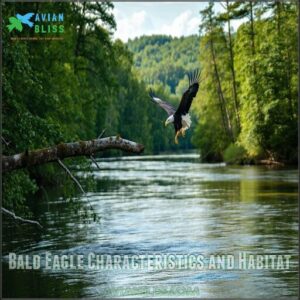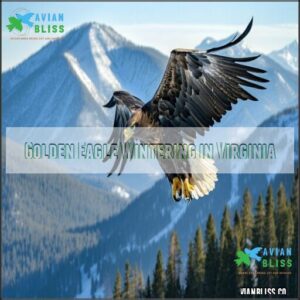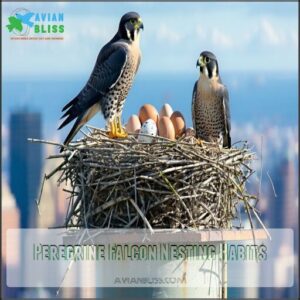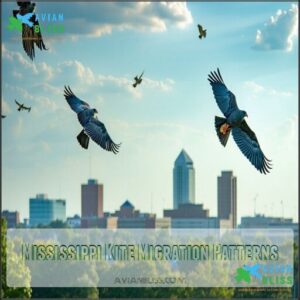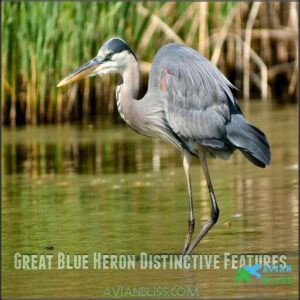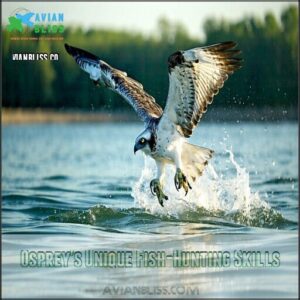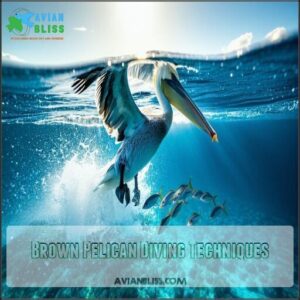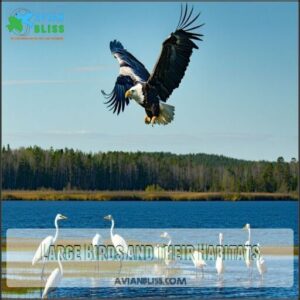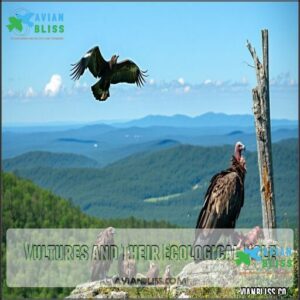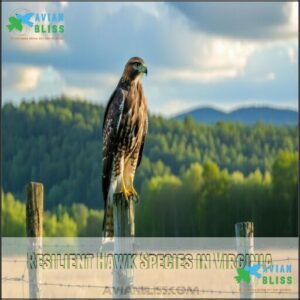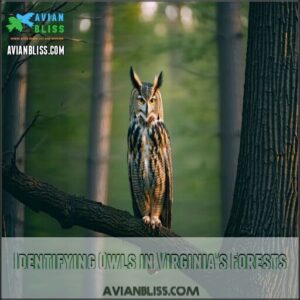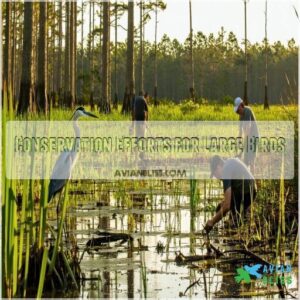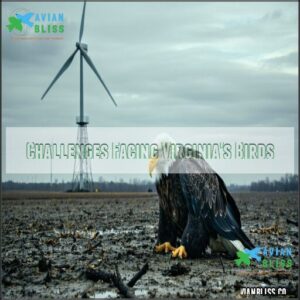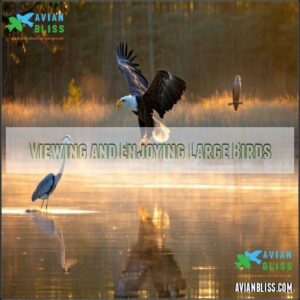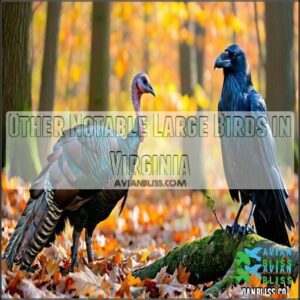This site is supported by our readers. We may earn a commission, at no cost to you, if you purchase through links.
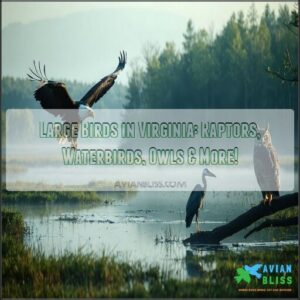
Bald Eagles and Golden Eagles dominate the skies with 6-7 foot wingspans, while Great Blue Herons stalk fish in shallow waters.
Turkey Vultures clean up roadside carrion with their distinctive red heads.
In forests, Great Horned Owls hunt silently at night, and Wild Turkeys strut through woodlands, displaying their surprising 6-foot wingspans when startled.
Brown Pelicans dive dramatically along coastal areas, and Virginia’s varied landscapes support these magnificent birds year-round or during migrations.
Knowing where to look in each season dramatically increases your chances of spotting these majestic creatures in their natural habitats, with diverse habitats and varied landscapes playing a crucial role.
Table Of Contents
- Key Takeaways
- Iconic Birds of Prey in Virginia
- Water Birds Commonly Found in Virginia
- Large Birds and Their Habitats
- Vultures and Their Ecological Role
- Resilient Hawk Species in Virginia
- Identifying Owls in Virginia’s Forests
- Conservation Efforts for Large Birds
- Challenges Facing Virginia’s Birds
- Viewing and Enjoying Large Birds
- Other Notable Large Birds in Virginia
- Frequently Asked Questions (FAQs)
- What birds live in Virginia?
- How many birds are in Virginia?
- What is the largest bird in Virginia?
- Where can you see birds in Virginia?
- What does a Virginian bird look like?
- What are the most common backyard birds in Virginia in winter?
- What are the big gray birds in Virginia?
- How can I identify a bird in my yard?
- What bird has long legs in Virginia?
- How do you identify a hawk in Virginia?
- Conclusion
Key Takeaways
- You’ll find impressive large birds across Virginia’s diverse landscapes, from Bald Eagles with 6-7 foot wingspans in coastal areas to Great Horned Owls hunting silently in forests at night.
- Virginia’s waterways support a variety of majestic water birds, including Great Blue Herons stalking fish in shallow waters, Ospreys showing unique fish-hunting skills, and Brown Pelicans performing dramatic dives along the coast.
- Both Black and Turkey Vultures serve as nature’s essential clean-up crew in Virginia, with highly acidic stomachs that neutralize harmful bacteria in decomposing animals, preventing disease spread throughout the ecosystem.
- Conservation efforts have significantly revived Virginia’s eagle and osprey populations since the 1972 DDT ban, though these magnificent birds still face challenges from habitat loss, pesticide exposure, and collisions with structures like wind turbines.
Iconic Birds of Prey in Virginia
You can spot some of Virginia’s most iconic birds of prey soaring through the skies, from the majestic Bald Eagle to the lightning-fast Peregrine Falcon.
These raptors play a pivotal role in the ecosystem, with unique traits and behaviors that make them fascinating to observe.
Bald Eagle Characteristics and Habitat
Bald eagles are among the most iconic Virginia bird species, known for their striking feather camouflage — brown bodies with distinguished white heads and tails.
These large birds in Virginia showcase impressive wing structures, enabling powerful flight.
You’ll typically see bald eagles near rivers, lakes, or coasts, as water-rich areas provide prime bird habitats in Virginia.
Their giant, stick-built nests are perched high in trees, supporting their eagle nesting needs year-round.
Their hunting tactics focus on fishing, but they’re opportunists, often scavenging or stealing meals.
This adaptable Bald Eagle diet includes fish, birds, and carrion.
- Thrive in water-side landscapes.
- Build massive nest structures.
- Scavenge fish, small birds, or carrion.
- Protected under bird conservation in Virginia.
- Represent strength and freedom—nature’s royalty!
Bald eagles, like other virginia birds of prey, have unique characteristics that set them apart from other bird species, showcasing their impressive wing structures and striking feather camouflage.
Golden Eagle Wintering in Virginia
Golden Eagles, some of the most breathtaking Virginia birds, find winter refuge in the state’s rugged mountains.
These powerful hunters rely on Virginia flyways to settle into their seasonal habitats.
Known for their mammalian diet, they symbolize strength and grace within Virginia wildlife.
Eagle conservation efforts play a key role in preserving their winter habitat and ensuring future generations can marvel at these majestic, large birds in Virginia.
Peregrine Falcon Nesting Habits
The Peregrine Falcon, one of the most adaptable Virginia birds, thrives in surprising places.
From rugged cliffs to towering skyscrapers and bridges, these falcons turn unexpected spots into prime nesting sites. By cleverly utilizing urban structures, they highlight how bird nesting can adapt to modern landscapes.
Peregrine Falcons use various nesting materials and establish secure spots to lay their eggs. During egg incubation, both parents take turns, ensuring the future of their falcon chicks.
This adaptability showcases their resilience, especially as large birds in Virginia continue to face environmental challenges. Supporting bird conservation helps secure safe nesting sites for this remarkable species.
Mississippi Kite Migration Patterns
As summer wanes and fall whispers its arrival, keep an eye out for the sleek and agile Mississippi Kite—one of the most fascinating bird species in Virginia.
These graceful fliers are remarkable for their precision and adaptability during their southbound journey.
Mississippi Kites favor cities and urban areas, showcasing their aerial acrobatics as they hunt insects like cicadas mid-flight.
They often travel in flocks and can be seen sharing Virginia’s skies with companion species like Broad-winged Hawks.
Here’s what you’ll love about them:
- Bug-catching experts swooping for cicadas on the wing.
- Social travelers, often flying together in groups.
- Masters of peaceful coexistence, never troubling hawk neighbors.
- Show off their sleek silhouettes in urban skies.
- Offer exciting moments for bird watching in Virginia.
Water Birds Commonly Found in Virginia
You’ll find Virginia’s waterways brimming with an array of fascinating birds that thrive in wetlands, rivers, and coastlines.
From the majestic Great Blue Heron to the skillful Osprey, each species has unique adaptations for life near water.
Great Blue Heron Distinctive Features
The Great Blue Heron stands as one of the most iconic bird species in Virginia.
Found in wetlands and along waterways, it’s hard to miss this elegant giant with its signature ‘S’-shaped neck folding during flight.
As a patient hunter, it stalks fish with precision, relying on its sharp, yellow beak shape to spear prey effortlessly.
Its feather colors beautifully blend gray, blue, and white hues, helping it camouflage in its surroundings.
The heron’s impressive wingspan, reaching up to 79 inches, is a true spectacle among Virginia’s large waterbirds.
Look closely at its long, grayish-blue leg feathers, which stand tall amidst shallow waters—perfectly adapted to its habitat.
This bird is both majestic and a joy for bird identification enthusiasts.
Osprey’s Unique Fish-Hunting Skills
Switching from wading to water-loving hunters, the Osprey stands out as an expert angler. Known for its stunning aerial acrobatics, this bird uses impeccable vision to spot fish from staggering heights before a breathtaking plunge. Its talons are uniquely adapted, with reversible outer toes—perfect for gripping slippery prey.
Watching an Osprey diving for fish is a masterclass in precision and patience.
For birdwatching in Virginia, here are tips:
- Scan rivers, lakes, and coasts for nests or hunting activity.
- Look for their impressive hovering before a dive.
- Identify by their brown body and white head.
- Appreciate nature’s ultimate fish-catching marvels!
Brown Pelican Diving Techniques
Brown pelicans (Pelecanus occidentalis) are showstoppers among large birds in Virginia, especially with their jaw-dropping bird diving techniques.
Imagine this: they climb over 30 feet, tuck their wings, and plunge toward the water with pinpoint accuracy.
Their diving methods involve specialized air sacs under their skin, cushioning the impact and protecting internal organs.
These incredible fliers target small fish, relying on sharp feeding habits and sturdy beak structure to scoop prey with ease.
Their plumage adaptation sheds water efficiently, keeping them streamlined after each plunge.
Watching a pelican in action feels like witnessing nature’s high-diving champion—graceful, resourceful, and endlessly fascinating to bird lovers.
Double-crested Cormorant Wing-Drying Behavior
Unlike many waterbirds, Double-crested Cormorants perform a distinctive wing-drying ritual that you’ll notice while bird watching in Virginia.
These large birds in Virginia lack the water-repellent oils that most aquatic species produce.
When observing Cormorant behavior along Virginia’s waterways, you’ll see:
- Wings held fully extended in a cross-like position, maximizing exposure to sun and wind
- Birds perched on exposed branches, rocks, or posts for ideal drying conditions
- Feather care sessions lasting 5-15 minutes, depending on humidity and temperature
- Slight wing vibrations to shake excess water from their feathers
This bird hygiene practice is essential for Double-crested Cormorants’ survival, as wet feathers impair flight and reduce insulation. Without proper wing drying, these remarkable birds couldn’t maintain their active fishing lifestyle.
Large Birds and Their Habitats
Virginia’s diverse landscape supports over 400 species of large birds, from the majestic Bald Eagle with its 71-91 inch wingspan to the Great Blue Heron standing up to 54 inches tall.
You’ll find these impressive creatures inhabiting specific ecosystems across the state, with Great Egrets preferring wetland edges, Tundra Swans migrating to coastal waters, and various raptors establishing territories in forests and open fields, including coastal waters.
Habitat Preferences of Great Egret
The Great Egret’s habitat preferences reveal a strategic approach to survival in Virginia’s diverse landscapes.
These elegant wading birds require specific conditions where security meets sustenance.
| Habitat Type | Characteristics | Bird Behavior |
|---|---|---|
| Wetland Habitats | Secluded woodland areas with mature trees | Nesting in colonies |
| Freshwater Lakes | Shallow waters near shorelines | Patient hunting stance |
| Coastal Areas | Protected from predators, often on islands | Feeding in smaller bodies than herons |
You’ll find these majestic birds where high-quality foraging areas meet protected nesting sites.
They’ve adapted to both natural marsh ecology and human-modified environments, making them resilient features of Virginia bird habitats.
Swamplands and Ibises in Virginia
Several of Virginia’s rich swamplands serve as prime waterfowl habitats for the distinctive glossy ibis. These waterbirds thrive in protected bird sanctuaries like the Great Dismal Swamp and coastal wetlands.
Ibis migration patterns bring these unique birds to Virginia’s diverse ecosystems seasonally. Wetland conservation efforts have helped maintain swamp ecology critical for their survival.
Virginia’s bird species diversity benefits from these protected areas, making them excellent spots for birdwatching. The glossy ibis’s curved bill makes it instantly recognizable among Virginia’s wetland inhabitants.
Understanding raptor conservation efforts is also vital for maintaining the state’s ecological balance.
Tundra Swan Migration and Living Areas
While ibises thrive in Virginia’s swamplands, tundra swans make their own remarkable presence known.
You’ll find these impressive birds migrating to Virginia’s wetlands from their Arctic breeding grounds each winter.
Tundra swans in Virginia:
- Travel over 3,500 miles during their annual migration
- Prefer shallow lakes, marshes, and agricultural fields
- Weigh up to 21 pounds with wingspans reaching 83 inches
- Form lifelong pair bonds and travel in family groups
- Feed primarily on aquatic vegetation and waste grain
These magnificent white birds represent one of Virginia’s largest waterfowl species.
Vultures and Their Ecological Role
You’ll find both Black and Turkey Vultures soaring above Virginia’s landscape with their impressive 60-72 inch wingspans, serving as nature’s efficient clean-up crew.
These large scavengers help prevent disease spread by consuming animal carcasses, making them essential components of Virginia’s ecological health despite their often misunderstood appearance, which highlights their role in maintaining ecological health.
American Vultures’ Feeding Habits
Virginia’s vultures serve as nature’s cleanup crew with fascinating feeding habits.
Turkey Vultures and Black Vultures locate carrion using exceptional smell and sight abilities.
Their highly acidic stomachs neutralize harmful bacteria in decomposing animals.
Scavenging behavior revolves around foraging strategies that target fresh roadkill and natural deaths.
These birds’ carrion feeding isn’t just about survival—their specialized food sources and vulture diets support critical Virginia bird conservation efforts.
Importance of Vultures in Ecosystems
After examining vultures’ feeding habits, let’s appreciate their broader ecological impact.
Virginia vultures – both Black and Turkey species – function as nature’s cleanup crew, providing ecosystem services worth millions of dollars annually.
Their scavenger role supports decomposition processes by efficiently removing carcasses that would otherwise spread disease.
The ecological niche these birds occupy is irreplaceable. When vultures consume rotting flesh, they’re preventing harmful bacteria like anthrax and rabies from proliferating.
Without these specialized scavengers, our environment would face serious health threats. Bird conservation efforts increasingly recognize vulture conservation as essential for maintaining ecosystem balance and Virginia bird species diversity, which is a critical aspect of preserving the ecosystem balance.
Resilient Hawk Species in Virginia
You’ll find several hawk species thriving across Virginia’s diverse landscapes, from the Red-tailed Hawk with its impressive 55-inch wingspan to the Red-shouldered Hawk known for hunting near water sources.
These adaptable raptors demonstrate remarkable resilience in both rural and suburban environments, making them some of the most frequently observed birds of prey in the state, showcasing their ability to thrive in various settings with remarkable resilience.
Red-tailed Hawk Adaptability
Red-tailed Hawks demonstrate remarkable adaptability across Virginia’s landscapes. Unlike vultures that clean up carrion, these hawks actively hunt live prey in diverse environments.
You’ll find these large birds thriving in woodland edges, agricultural fields, and even urban centers. Their success stems from flexible hunting strategies and nesting habits.
They’re a larger species, with wingspans up to 52.4 inches.
- Red-tailed Hawks hunt using both "sit-and-wait" tactics and high-altitude soaring to spot prey
- Their nesting habits adapt to available resources – using tall trees in rural areas and building ledges in cities
- During hawk migration, Virginia serves as a vital pathway for these birds
- Feather camouflage varies among the 14 subspecies, with Virginia hawks generally larger than other U.S. populations
- Urban adaptation has allowed these birds to expand their range when many other species are declining
Red-shouldered Hawk Unique Hunting Style
Unlike other large raptors, the Red-shouldered Hawk excels as an ambush predator in Virginia’s forested wetlands.
You’ll find this medium-sized hawk perching silently beneath the forest canopy, using its exceptional visual acuity to spot amphibians, small mammals, and crayfish below.
Forest hunting requires patience—these Virginia hawks wait motionless before swooping down to snatch prey with precise timing.
Their prey specialization includes frogs, toads, and snakes, making them frequent visitors to wooded streams and ponds.
Their hunting success relies on surprise rather than pursuit, a distinctive bird behavior among large raptors.
Identifying Owls in Virginia’s Forests
You’ll find owls in Virginia’s forests by identifying their distinctive features like the Great Horned Owl‘s prominent ear tufts or the Barred Owl’s unique hooting pattern.
Virginia’s mature woodlands provide ideal habitat for these nocturnal hunters, with the Great Horned Owl reaching up to 25 inches in length with a wingspan of 3-5 feet.
Great Horned Owl’s Distinctive Features
Among Virginia’s large raptors, the Great Horned Owl (Bubo virginianus) stands out with its unmistakable features.
You’ll recognize this powerful predator by its yellow eyes surrounded by prominent facial discs and distinctive tufted ears.
Weighing 2-5.5 pounds and measuring 18-25 inches, these nocturnal hunters possess a white throat patch and barred feather pattern on their underside.
Their silent flight and powerful talons make them formidable night hunters in Virginia’s forests.
When birding, listen for their deep, resonant hooting.
Barred Owl’s Vocalization Patterns
While the Great Horned Owl impresses with its physical features, the Barred Owl captivates Virginia forests with its remarkable vocal repertoire. You’ll instantly recognize their distinctive "**who cooks for you, who cooks for you all?
**" call echoing through wooded areas, especially near water sources.
These Virginia owls employ acoustic communication for multiple purposes:
- Territorial Defense: Males use deep, resonant hoots to establish and protect their hunting grounds
- Mating Rituals: During breeding season, pairs perform synchronized calling duets
- Call Variations: Beyond their signature phrase, they produce barks, screams, and "monkey calls" when agitated
Barred Owls demonstrate impressive vocal flexibility, with variations based on season, time of day, and environmental conditions. Their vocalizations create an auditory map of their territory, helping them navigate the darkness and communicate with potential mates. Virginia birding enthusiasts often identify these medium-sized owls by sound before sight. They also use bill snapping sounds during territorial disputes.
Conservation Efforts for Large Birds
You’ll find that conservation efforts have revived Virginia’s eagle and osprey populations substantially since the ban of DDT pesticides in 1972.
Virginia hosts numerous organizations dedicated to protecting large bird habitats throughout the state’s diverse ecosystems from coastal wetlands to mountainous forests.
Impact of DDT on Bird Populations
The widespread use of DDT devastated Virginia’s bird populations through bioaccumulation effects.
This pesticide created a silent crisis for bald eagles and ospreys by causing severe eggshell thinning.
When parent birds sat on their nests, their body weight alone crushed the fragile eggs, leading to catastrophic population decline.
By the 1970s, bald eagles had nearly vanished from Virginia, with fewer than 100 pairs remaining.
DDT’s toxic legacy extended to other species, with peregrine falcons disappearing entirely from eastern regions.
The 1972 ban marked a turning point in bird conservation efforts.
Since then, ecosystem recovery has been remarkable – you’ll now find healthy populations thriving along Virginia’s waterways, showcasing the resilience of nature when harmful substances are removed from the environment.
Role of Endangered Species Act
The Endangered Species Act serves as a vital shield for Virginia’s large birds facing extinction threats.
When you understand how it works, you’ll see why it’s essential for bird conservation efforts:
- Legal protections prevent harmful activities in critical nesting areas
- Habitat preservation helps Virginia eagles and other species maintain territories
- Population recovery programs have helped the Bald Eagle bounce back from near-extinction
- Funding allocation supports ongoing monitoring and research
This landmark legislation provides the framework for all bird conservation organizations to coordinate their work effectively.
Despite facing legal challenges, the Act continues to safeguard vulnerable species through its thorough approach to protection and recovery.
Organizations Advocating for Bird Safety
While the Endangered Species Act provides legal protection, dedicated organizations work tirelessly on the front lines of bird safety in Virginia.
Bird Safe NOVA partners with the Northern Virginia Bird Alliance to reduce hazards from light pollution and window collisions through advocacy initiatives and public awareness campaigns. They’re actively pushing for bird-friendly building designs and legislative solutions to protect our feathered neighbors.
In coastal areas, Bird Safe Hampton Roads promotes their Lights Out program during migration seasons when birds are most vulnerable. The Virginia Osprey Foundation focuses specifically on conservation and habitat preservation for these magnificent fishing raptors.
To mitigate window strikes, consider installing specialized window films. These bird conservation organizations secure funding for rescue & rehabilitation efforts across the state, ensuring Virginia’s skies remain filled with diverse avian species for generations to come.
Challenges Facing Virginia’s Birds
You’ll find Virginia’s large birds facing significant threats from habitat destruction, pesticide exposure, and collisions with structures like wind turbines.
These magnificent creatures need your awareness and support as they navigate increasingly fragmented environments and contaminated ecosystems that compromise their survival.
Habitat Loss and Preservation Needs
Building on our conservation discussion, Virginia’s large birds now face unprecedented habitat challenges.
The loss of natural spaces threatens their very existence.
Virginia’s bird habitats are disappearing at alarming rates, with consequences rippling through entire ecosystems.
Research shows biodiversity doubles with every tenfold increase in habitat area, making preservation critical for large birds in Virginia.
Four major habitat threats facing Virginia’s birds include:
- Residential development – Converting natural lands into housing developments fragments vital habitats
- Wetland drainage – Loss of marshes impacts species like the declining King Rail
- Forest fragmentation – Breaking continuous forests into isolated patches
- Coastal development – Threatening barrier island habitats essential for migratory species
Bird sanctuaries and forest management initiatives offer hope, but immediate action remains essential.
Risks From Pesticides and Pollution
While habitats may be restored, chemical threats remain persistent.
Virginia’s large birds face serious risks from pesticide exposure and environmental contaminants.
The 2025 State of the Birds report shows over one-third of U.S. bird species are of high conservation concern.
Recent reports indicate significant bird declines are impacting Virginia.
| Threat | Impact on Virginia Birds |
|---|---|
| Pesticide Exposure | Increased offspring mortality |
| Lead Poisoning | Affects raptor populations |
| Mercury Bioaccumulation | Contaminates aquatic food chains |
| Plastic Ingestion | Threatens waterbird health |
Bird conservation efforts must address these pollution sources to protect declining bird populations, which is a matter of serious risks and requires immediate attention to prevent further declines.
Collision Threats From Wind Turbines
While pesticides threaten birds, wind turbines present another challenge for Virginia’s large avian species. These rotating blades can be deadly obstacles, especially for eagles, hawks, and migrating birds.
- Turbine placement near migration routes increases bird mortality rates
- Black-painted blades can reduce collisions by up to 70%
- Bird conservation efforts include pre-construction impact assessments
- Nighttime shutdowns during peak migration periods save lives
- Future research focuses on technologies that detect and deter approaching birds
You’ll find mitigation strategies improving as bird population trends inform conservation decisions. Wind turbines can also disrupt red kite foraging behavior, impacting hunting effectiveness.
Viewing and Enjoying Large Birds
You’ll find exceptional birdwatching opportunities throughout Virginia’s diverse habitats, from coastal wetlands where herons wade to mountain forests where raptors soar.
You can maximize your chances of spotting large birds by visiting popular locations like Belle Haven Marina for ospreys or Great Dismal Swamp for warblers during their peak seasonal activity periods.
Birdwatching Hotspots in Virginia
Virginia offers an abundance of remarkable birdwatching hotspots where you can observe large birds in their natural habitats.
At Chincoteague National Wildlife Refuge, you’ll discover over 300 species across windswept beaches and marshes. Huntley Meadows Park boasts 200+ species within its 1,500 acres of forests, meadows, and wetlands.
For mountain habitats, Shenandoah National Park provides diverse ecosystems perfect for spotting various large birds in Virginia.
Don’t miss Dutch Gap along the James River or Back Bay National Wildlife Refuge for coastal birding experiences. These wetland wonders host everything from majestic raptors to elegant waterbirds.
For those seeking further resources, a regional guide is available. Whether you’re drawn to seasonal migrations or urban birding opportunities, Virginia’s birdwatching spots offer year-round viewing possibilities for bird enthusiasts of all levels.
Best Times to Observe Migrating Species
Now that you know where to spot Virginia’s large birds, timing your visits is equally important. Peak migration seasons offer spectacular bird watching opportunities throughout the state.
Spring migration (March-May) and fall migration (August-November) transform Virginia’s skies as birds travel along Coastal Flyways and Inland Routes. Weather Influence substantially affects bird movement, with clear days following cold fronts providing ideal viewing conditions. Many resources discuss Virginia bird patterns.
- Dawn hours (5:30-9:00 AM) offer prime viewing of warblers and raptors
- Coastal areas peak during October for shorebirds and waterfowl
- Hawk-watching reaches its height in September at mountain ridges
For best results, check local bird watching Virginia reports before planning your trip.
Other Notable Large Birds in Virginia
You’ll find Virginia hosts several remarkable large birds beyond raptors and waterbirds, including the wild turkey weighing up to 381 ounces and the intelligent common raven with a wingspan reaching 60 inches.
These impressive species inhabit diverse environments from mixed forests to mountainous regions, displaying unique behaviors that make them fascinating subjects for observation.
Wild Turkey and Its Natural Habitat
You’ll find the Wild Turkey (Meleagris gallopavo) wandering through Virginia’s wooded landscapes, where these ground-dwelling birds thrive in mixed forest habitats.
These impressive wild birds reach weights up to 24 pounds, making them among Virginia’s largest native land birds.
Wild Turkeys display remarkable diet diversity:
- Consuming acorns, seeds, and berries during fall and winter
- Hunting insects, salamanders, and small reptiles in warmer months
- Adjusting their feeding patterns based on seasonal availability
Their elaborate mating rituals occur in spring, when males fan their tail feathers and gobble to attract females.
Population management efforts have successfully restored these birds across the state after near-extinction in the early 1900s.
Despite regulated hunting impact, Wild Turkeys maintain stable numbers in Virginia’s diverse forest ecosystems, with a stable population and diverse diet.
Common Raven’s Intelligence and Behavior
While wild turkeys roam Virginia’s woodlands, the common raven showcases nature’s brilliance in an entirely different way.
These impressive black birds demonstrate remarkable problem-solving abilities that rival great apes. You’ll be amazed watching ravens use tools, plan for future events, and remember human faces for years.
Their social behavior involves complex communication through various calls and body language.
| Raven Ability | Description | Where to Observe |
|---|---|---|
| Tool use | Creates and manipulates objects | Mountain forests |
| Social learning | Teaches skills to others | Open landscapes |
| Memory | Recalls food locations for years | Throughout Virginia |
Ravens form lifelong pair bonds but occasionally display non-monogamous behavior. Their graceful flight includes rolls and dives, showcasing their physical adaptations alongside their remarkable intelligence.
Frequently Asked Questions (FAQs)
What birds live in Virginia?
You’ll discover over 400 bird species in Virginia, from majestic Bald Eagles and Great Blue Herons to smaller songbirds.
They inhabit diverse ecosystems from coastal regions to mountainous areas, with both migratory and resident populations, including diverse ecosystems.
How many birds are in Virginia?
You’d think counting birds would be simple!
Virginia hosts over 400 bird species, including every naturally occurring East Coast species.
Conservation efforts have revived eagle and osprey populations across the state’s diverse coastal and mountainous regions.
What is the largest bird in Virginia?
The Mute Swan is Virginia’s largest bird, weighing up to 416 ounces with a 96-inch wingspan. You’ll find these non-native giants in shallow wetlands and city parks throughout the state.
Where can you see birds in Virginia?
With over 400 bird species in Virginia, you’ll find excellent viewing at Belle Haven Marina, Huntley Meadows Park, Great Dismal Swamp, Assateague Island, and Virginia Beach.
Each location offers unique habitats for diverse bird watching, making Virginia a prime destination for this activity, with diverse bird species to observe.
What does a Virginian bird look like?
Virginia’s birds vary widely in appearance.
You’ll see everything from tiny chickadees to majestic bald eagles.
Their plumage ranges from vibrant cardinal reds to subtle warbler yellows, depending on the species you encounter.
What are the most common backyard birds in Virginia in winter?
Like crimson beacons against winter’s canvas, Northern Cardinals dominate your Virginia backyard in winter, joined by chickadees, titmice, finches, and woodpeckers seeking food from your feeders during cold months.
What are the big gray birds in Virginia?
You’ll commonly see Great Blue Herons, a tall gray bird with an S-shaped neck, near Virginia’s waterways. Other gray birds include Mourning Doves, Northern Mockingbirds, and the larger Canada Goose.
How can I identify a bird in my yard?
Just as you’d spot a friend in a crowd, you can identify your yard visitor by noting its size, colors, bill shape, and behavior.
Take photos and use bird identification apps or field guides.
What bird has long legs in Virginia?
You’ll find several long-legged birds in Virginia, including Great Blue Herons, Great Egrets, and Sandhill Cranes.
These elegant waders use their extended limbs to navigate wetlands while hunting for fish and amphibians.
How do you identify a hawk in Virginia?
Look for key features: broad wings, hooked beak, sharp talons, and keen eyes.
You’ll notice hawks soaring in circles or perched on poles.
Virginia’s common species include Red-tailed, Cooper’s, and Sharp-shinned hawks.
Conclusion
Virginia’s large birds offer a bird’s-eye view into our state’s natural richness.
Whether you’re spotting Bald Eagles soaring overhead or Great Blue Herons wading through marshes, these magnificent creatures connect us to wild spaces.
You’ll find large birds in Virginia year-round if you know where to look.
Remember to bring binoculars, maintain respectful distances, and support conservation efforts.
The preservation of diverse habitats guarantees these impressive birds will continue to inspire future generations of Virginians.

